Italy’s Sanctuary of Madonna della Corona has at its heart that striking church that is half-hewn into the rocks and seems suspended halfway between Heaven and Earth.
You will find it near the small village of Spiazzi which is a stone’s throw away from the City of Love, Verona and just off Lago di Garda, Italy’s largest lake.
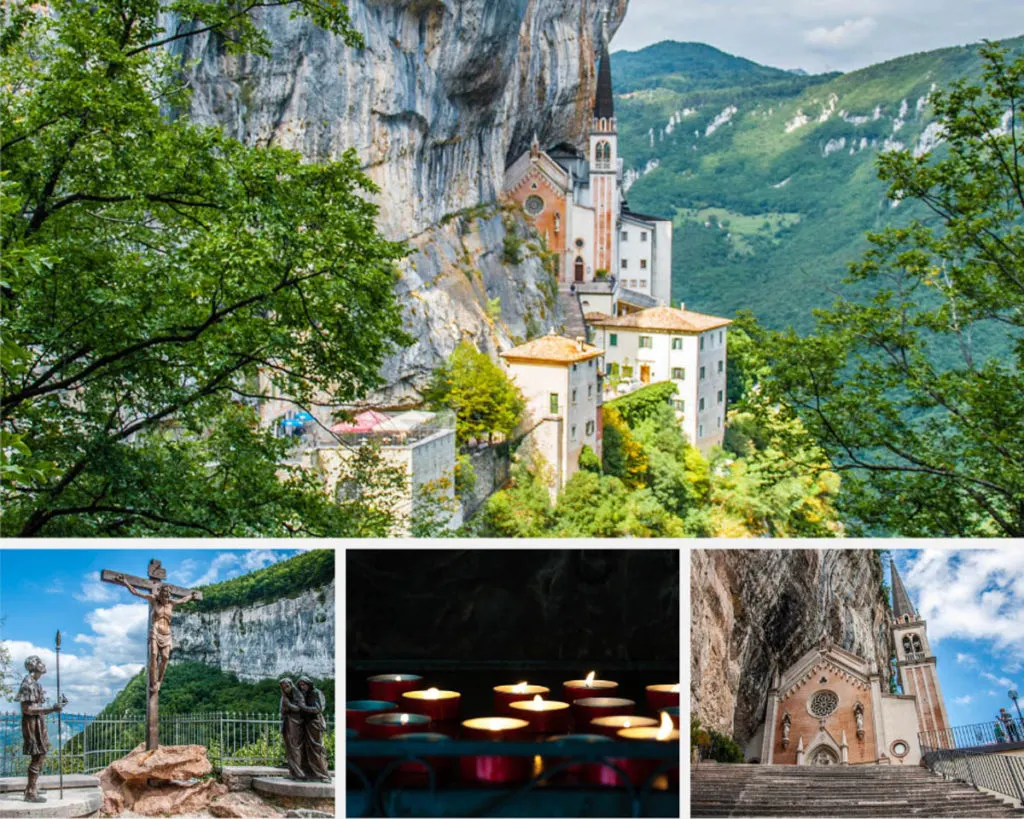
Much more than providing instagrammable fodder and an excuse for social likes, the Santuario della Madonna della Corona (in English, Sanctuary of Our Lady of the Crown) is a special place to visit and explore. It brings you closer to the people of this land, their history, traditions, and beliefs.
Above all, it’s a testament to their spirit as building and maintaining a sanctuary halfway up a cliff face is a sign of devotion that nowadays we rarely seem to cultivate in our busy daily lives.
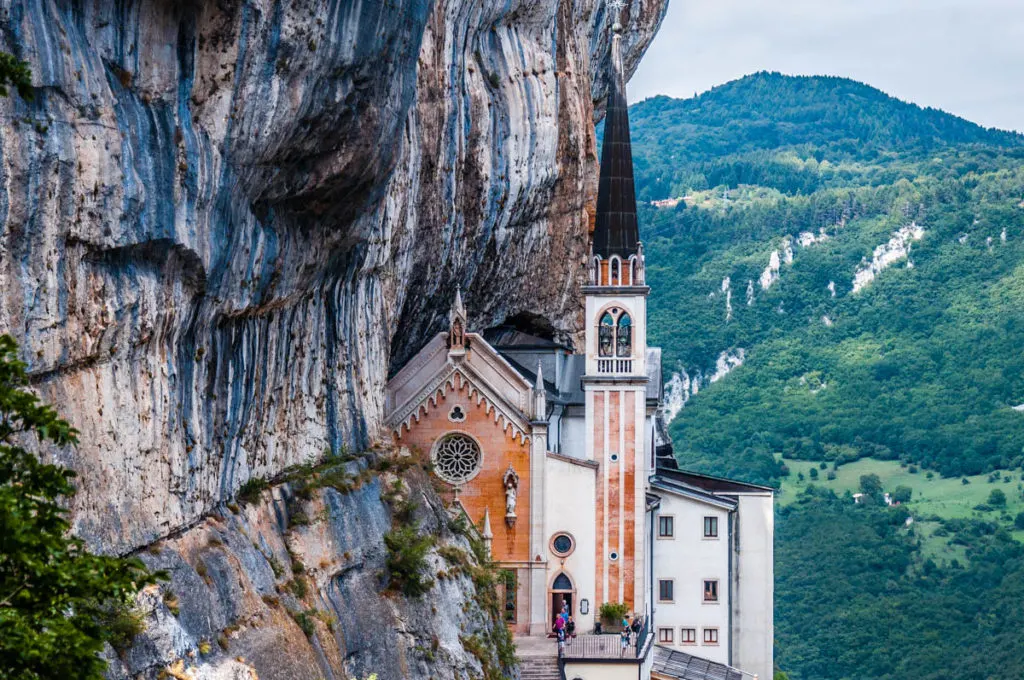
Visiting the Sanctuary of Madonna della Corona is a touching and memorable experience. It also requires some physical strength if you decide to walk to it rather than take the small shuttle bus from Spiazzi down to the church.
Most importantly, a visit to the sanctuary gives you a chance to appreciate the stunning beauty of its unique location – the incredibly tall mountains on the vertical slope of which it is built, the valley stretching down below, the river Adige meandering through, and then the salmon-coloured church peaking behind the cragged rocks while its bell tower is forever reaching for the sky above.
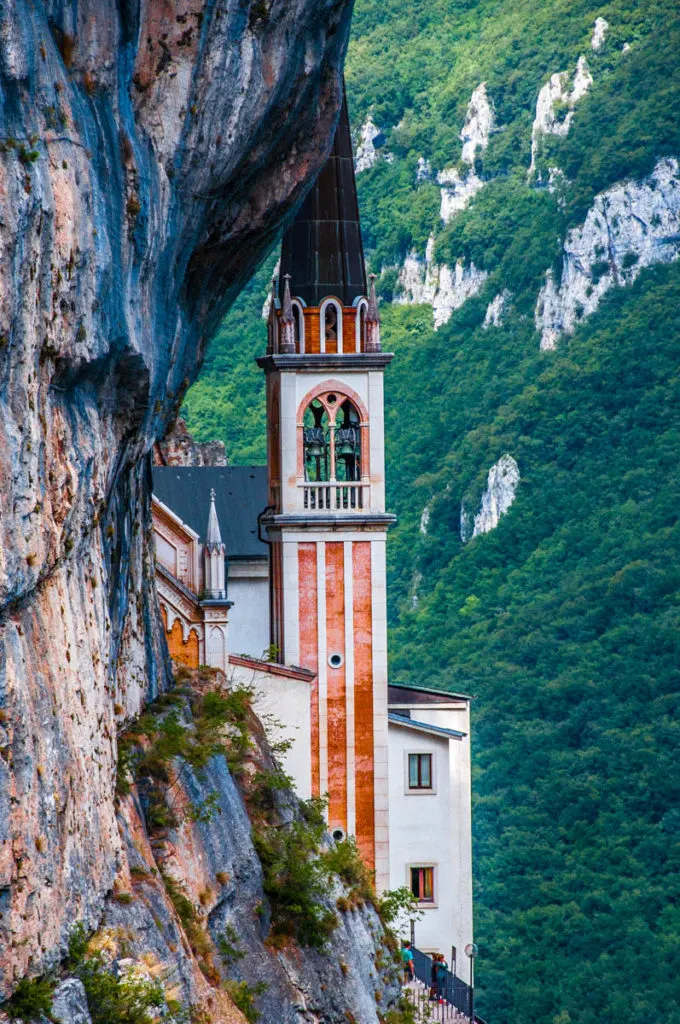
The first time that I had the chance to visit the Sanctuary of Madonna della Corona, it was on a warm sunny day in the midst of the glorious Italian summer. The mountains, covered in their lush dress, were beautifully offset by the intensely blue skies.
I followed the road leading you curve by curve from the small hilltop village of Spiazzi to the sanctuary further down the cliff. Along the way, I stopped at every Station of the Cross thus completing the Via Crucis – a path flanked by sculptural depictions of Christ and the events on his Crucifixion.
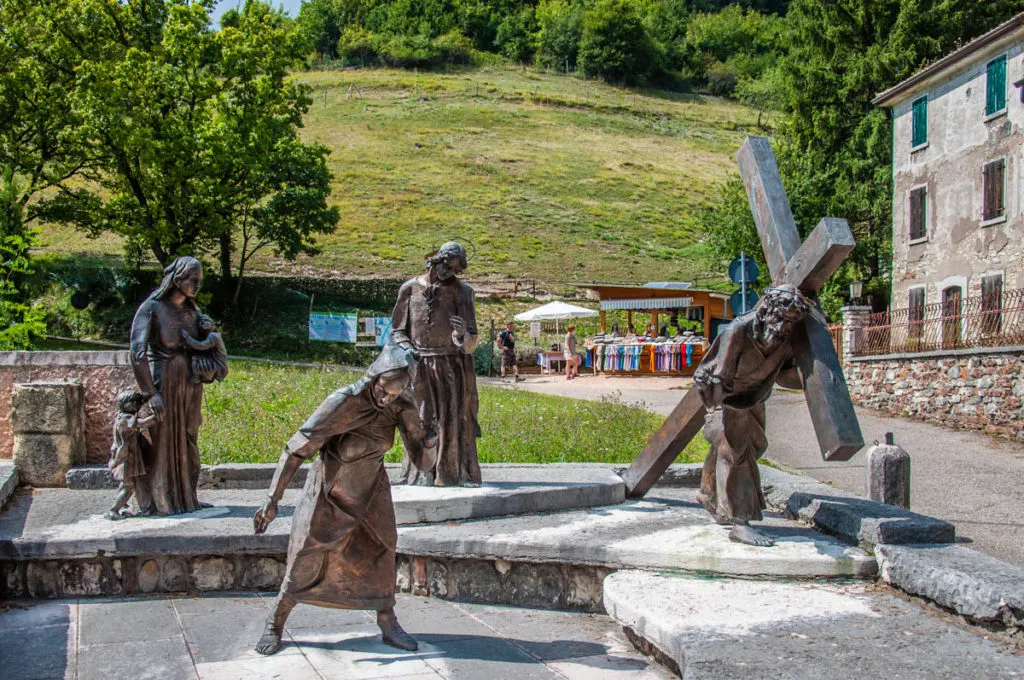
Before long I reached the point which gave me my first view of the sanctuary.
Take it from me! The first view of the Sanctuary of Madonna della Corona is breathtaking.
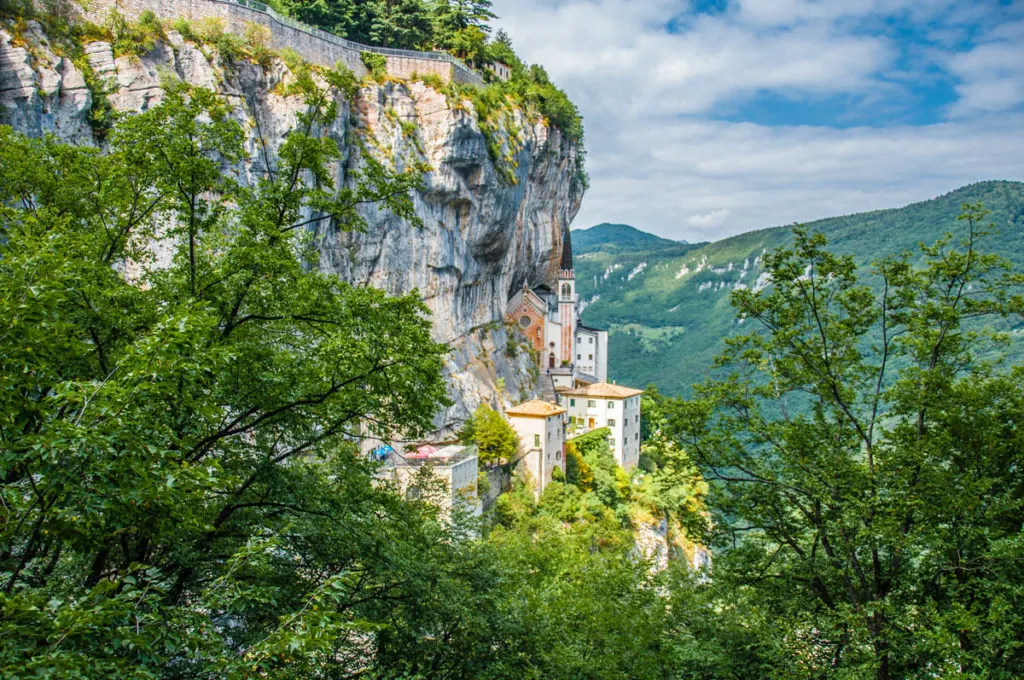
Just as I stole my first glimpse of that salmon-coloured church with a neo-Gothic facade framed by the lush greens of the mountains and the blue sky above, the bells in the tower started singing their midday song.
The melody – twinkling and sweet – swelled over the valley and soared high in the sky. It was a special moment connecting Heaven and Earth. Standing on the edge between the two realms, I felt a sense of wonder. Gratitude for the beauty of this world bloomed in my heart. Even the rocky face of a cliff was not a barrier for people. Inspiration and courage were all that was needed to create something new and then make it last through the centuries.
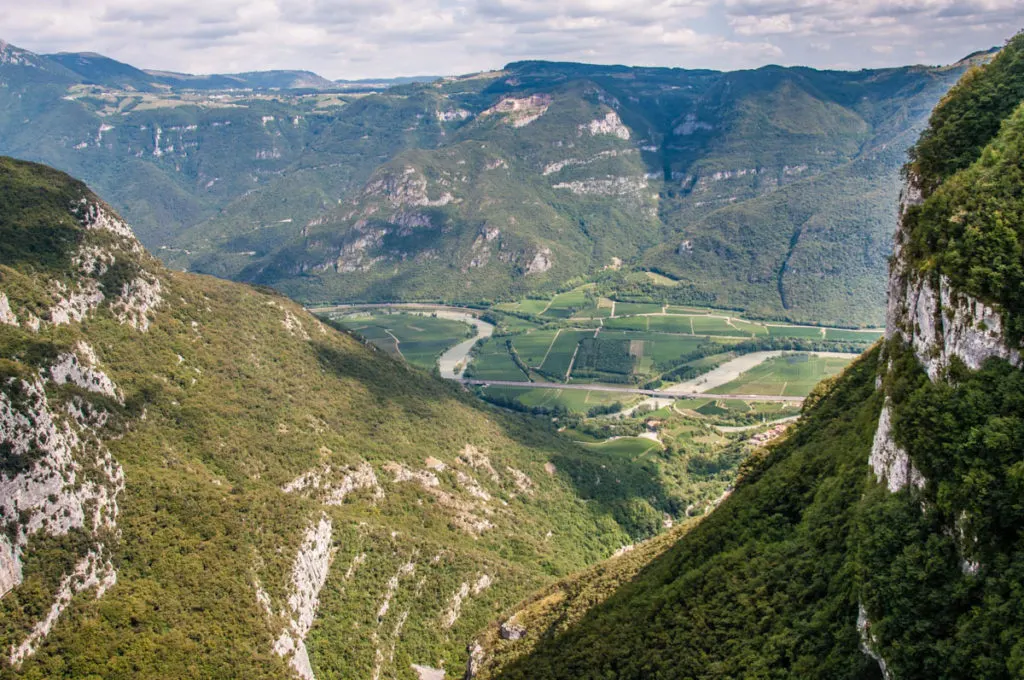
So, in this blog post today, I want to share with you how to visit the Sanctuary of Madonna della Corona in Italy. Organised under helpful headings below, you will find practical bite-size information about how to get there, what to see, and even what other sanctuaries and destinations to visit nearby.
I hope that all my actionable, first-hand tried and tested tips will inspire you to visit this must-see Italian place and have a wonderful travel experience.
Read on!
Sanctuary of Madonna della Corona – Visiting Italy’s Church Suspended Between Heaven and Earth
Pin for Later!
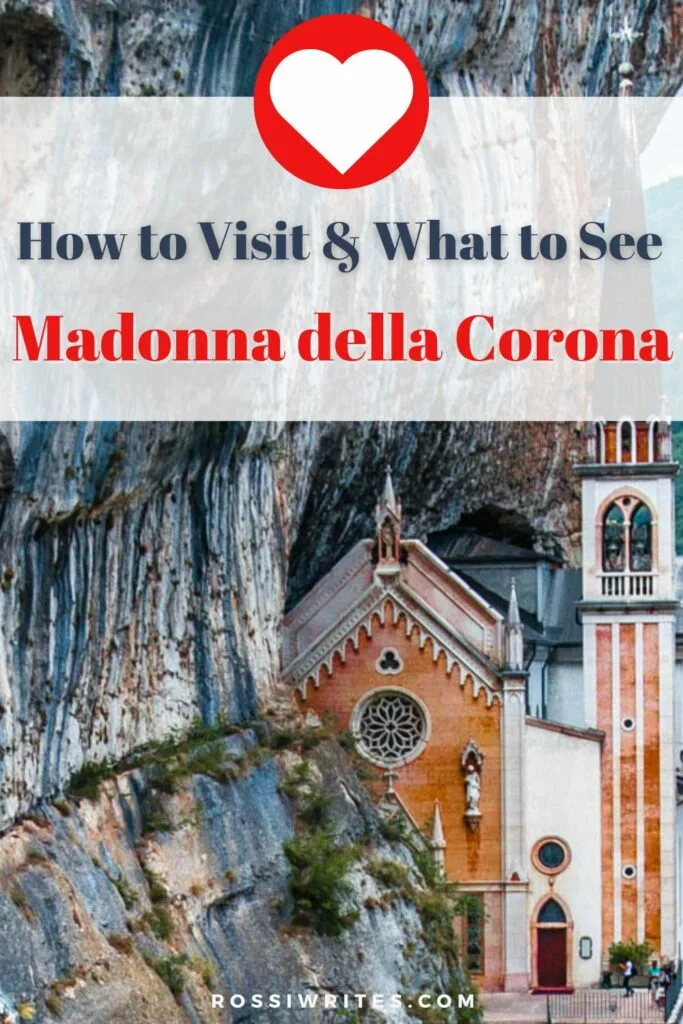

Where in Italy Is the Sanctuary of Madonna della Corona?
The above map shows you the exact location of the Sanctuary of Madonna della Corona in Italy. It stands on a steep cliffside in Monte Baldo – a long mountain range which separates the eastern shore of Lake Garda from the deep valley of the River Adige.
The sanctuary is about 650 m away from the small village of Spiazzi which is a half-an-hour uphill drive away from the town of Garda – one of the prettiest small towns on the shores of Lake Garda. The surroundings of the sanctuary are dotted with mountain huts, small dairy farms, and picturesque villages (many of which were settled as far back as the late Middle Ages). Dozens of hiking paths crisscross the adjacent lush meadows and forests.
Administratively, the Sanctuary of Madonna della Corona and the village of Spiazzi are part of the territory of the Province of Verona which belongs to the northeastern Italian region of Veneto. The sanctuary is about 46 km (less than an hour’s drive) away from Verona.
Is the Sanctuary of Madonna della Corona Worth a Visit?
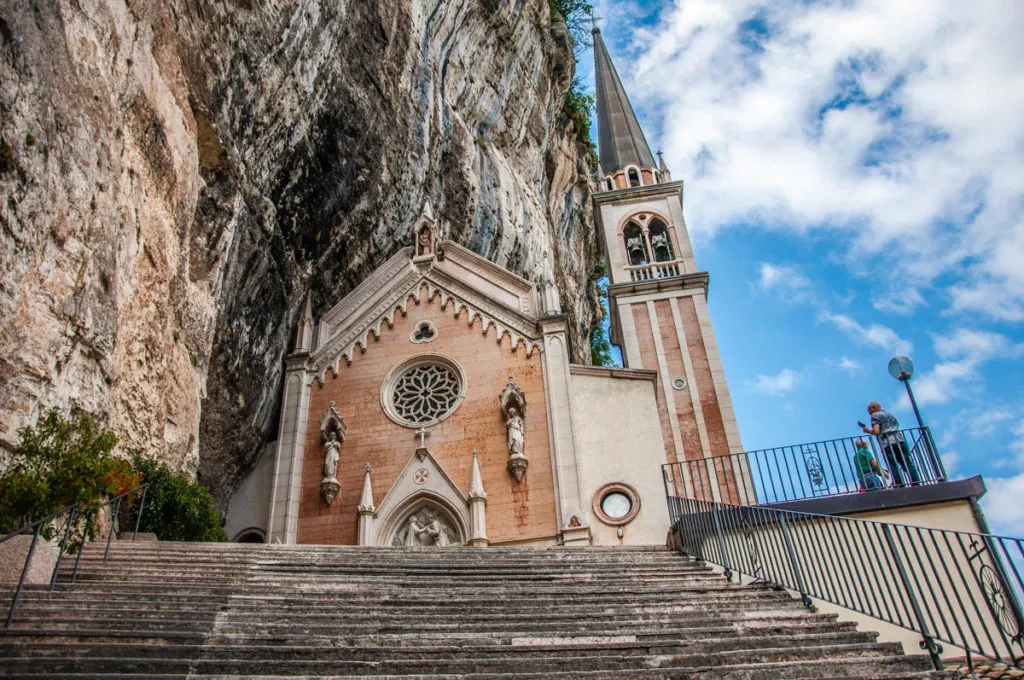
The Santuario della Madonna della Corona is one of Italy’s most well-known sanctuaries dedicated to the Virgin Mary.
It is built on a rocky terrace which stands at a height of 774 m and overlooks the valley of the river Adige. Its church is half-hewn into the craggy slopes of the mountain range of Monte Baldo. Seen from afar, the sanctuary appears to be suspended halfway between Earth and Heaven and it thus seems to defy the laws of gravity. With its centuries-old history and religious traditions, it attracts scores of pilgrims throughout the year.
An incredibly serene place, a visit to the sanctuary leaves a deep impression. No matter how religious or not you may be, seeing the salmon-coloured church emerge on the side of the vertical cliff as you turn the corner of the path leading to it, is an experience that makes you stop in your tracks and contemplate the beauty and the resilience of this world for a moment or two.
When I originally wrote this blog post in 2019, the Sanctuary of Madonna della Corona was well-known in Veneto and northern Italy. On feast days, it would attract large crowds and the rest of the time it was a rather peaceful, contemplative place.
Since then, its popularity on social media has grown exponentially and nowadays the sanctuary attracts more and more visitors eager to photograph it from all possible angles. I often find whole paragraphs copied verbatim (and without my permission) from this blog post to caption photos and videos of this special place on Instagram and YouTube.
If you decide to visit the sanctuary, head there to enjoy its unique beauty and atmosphere and not just to show off on social media. Walk the paths leading to the church, breathe the air of the forests and the mountain, let your heart soar at the sight of the deep valley and the vertical cliffs. Don’t just tick the sanctuary off a bucket list but truly delve into its history and its traditions.
After reading so much about the sanctuary online and watching endless videos of it from all possible angles, some people experience disappointment when they finally make it there. ‘Is that it?’, they say. ‘It’s just a church!’, others add. This is why it is important to visit this special place for the right reasons – centuries-old history, gorgeous views, an invigorating hike, and the ability to experience a place on a more elevated level than simply as a backdrop to a photo or two.
Abridged History of the Sanctuary of Madonna della Corona
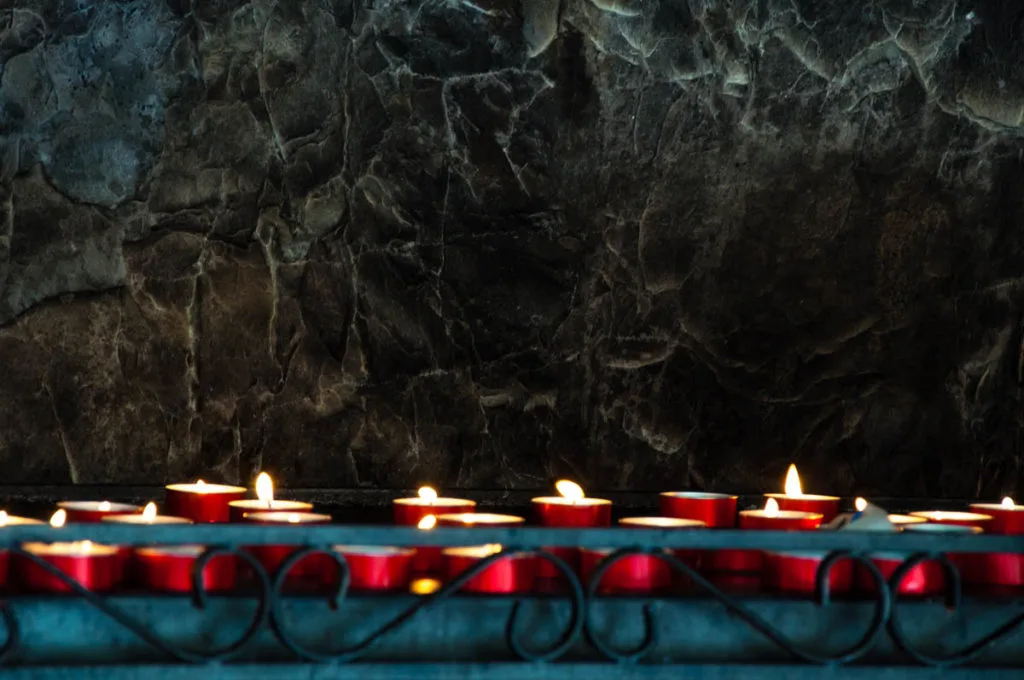
The Sanctuary of Madonna della Corona has a long history stretching centuries back in time.
They say that with its quiet beauty this place – although incredibly difficult to reach in the past – has been attracting people even before the dawn of Christianity. Around the year 1000 AD, monks from the Monastery of San Zeno in nearby Verona set up a hermitage where the sanctuary now stands. They would retreat there from the world to live in solitude and contemplation.
A narrow and treacherous path led to their hermitage. Yet, the beauty and the peace of the location kept attracting people and by the second half of the 13th century, there was already a monastery with a chapel where the Madonna of Monte Baldo was venerated.
In 1522, a miracle happened.
A small sculpture of Pietà – the Madonna cradling the dead body of Christ – was transported by angelic intervention from the island of Rhodes to where the sanctuary now stands. At the time, Rhodes had just fallen prey to the invading Ottoman Empire.
However, there is a different version as to how the Pietà ended at the sanctuary. It is much less miraculous than the first one, as it simply states that the statue was donated in 1432 by the local feudal lord Ludovico di Castelbarco.
The Pietà is made of stone from South Tyrol, it is 70 cm high, 56 cm wide and 25 cm deep. It stands on a pedestal with the inscription HOC OPUS FECIT FIERI LODOVICUS D CASTROBARCO D 1432 which, according to the supporters of the second version proves that the statue was donated by Ludovico.
The first church was built here between 1480 and 1522. It was inaugurated in 1530 after a visit from the Bishop of Verona – Gian Matteo Giberti. In 1625 it became a sanctuary under the name of Santa Maria of Monte Baldo and the religious Order of the Knights of St. John had the church rebuilt. It was a large-scale project which was only concluded in 1680.
Since then the church of the Sanctuary of Madonna della Corona has been enlarged, re-built, and renovated several times. For centuries, all the construction materials for it were brought up here by hand. Before a road was built, a wooden winch was sometimes used to lower them down the cliff.
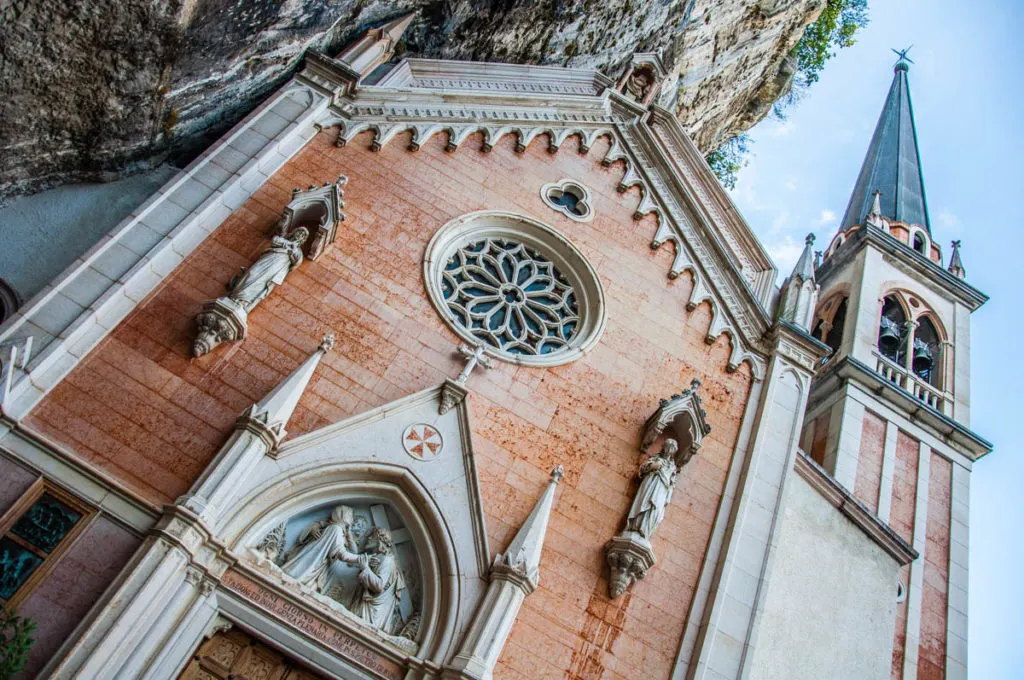
The facade as we see it today was erected in 1899. It’s in the neo-Gothic style and decorated with marble from Sant’Ambrogio – a small town in the nearby valley of Valpolicella.
Between 1975 and 1978 the church underwent a major renovation. To significantly expand it, large portions of the previous church were demolished while care was taken to preserve the facade and other significant parts. During the work, it was also dug into the rock, hence nowadays parts of the north wall and the entire west wall of the church are simply the craggy cliff face. As a result, the area of the church was almost tripled. From 220 sqm it was enlarged to 600 sqm. It is now 30 m long, 20 m wide and its dome is 18 m high.
In July 1982, Pope John Paul II elevated the sanctuary to a minor basilica.
Known initially as the Sanctuary of the Madonna of Monte Baldo, after the arrival of the statue of Pietà in the 16th century, the local people began to call it the Santuario della Madonna Addolorata (in English, Sanctuary of Our Lady of Sorrows). Nowadays, the name Madonna della Corona is the most widely used one. They say that it was inspired by the crown that the mountain peaks form around the sanctuary.
It’s interesting to note that the Sanctuary of Madonna della Corona is the end point of the Cammino dei Due Santuari (in English, Path of the Two Sanctuaries). The path begins from the Sanctuary of Pieve di Chiampo, crosses seven valleys of the Venetian Pre-Alps and ends at the Sanctuary of Madonna della Corona. This pilgrimage takes you through lush forests and fields dotted with small chapels which are a testament to the religious and spiritual traditions and fervour of the locals.
What to See in the Sanctuary of Madonna della Corona?
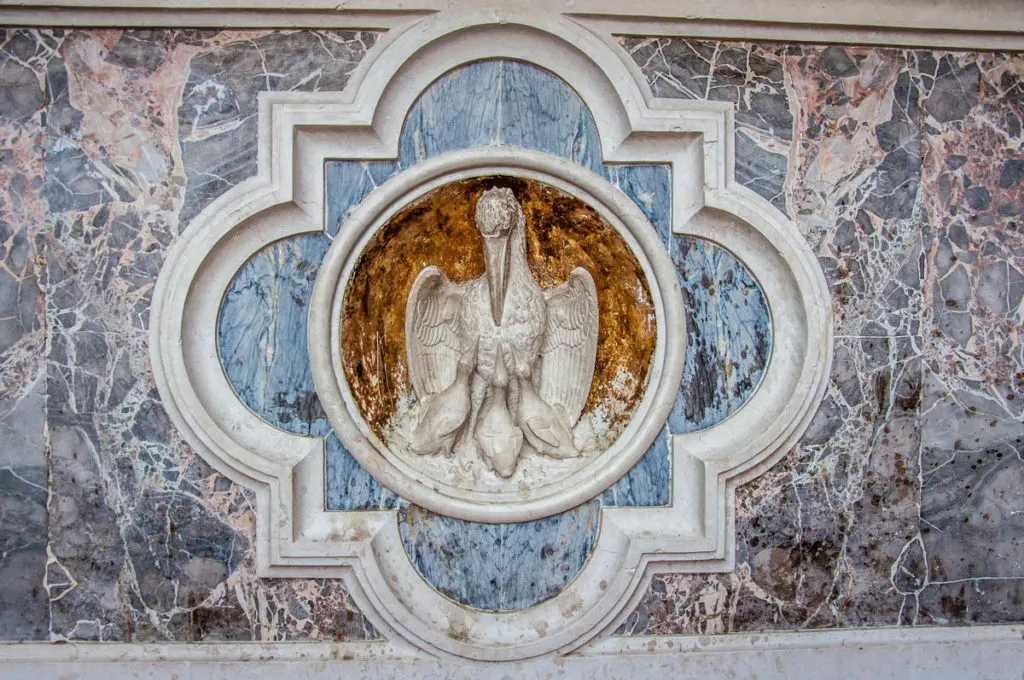
There are many things to see in the Sanctuary of Madonna della Corona. Here is a short list for your convenience:
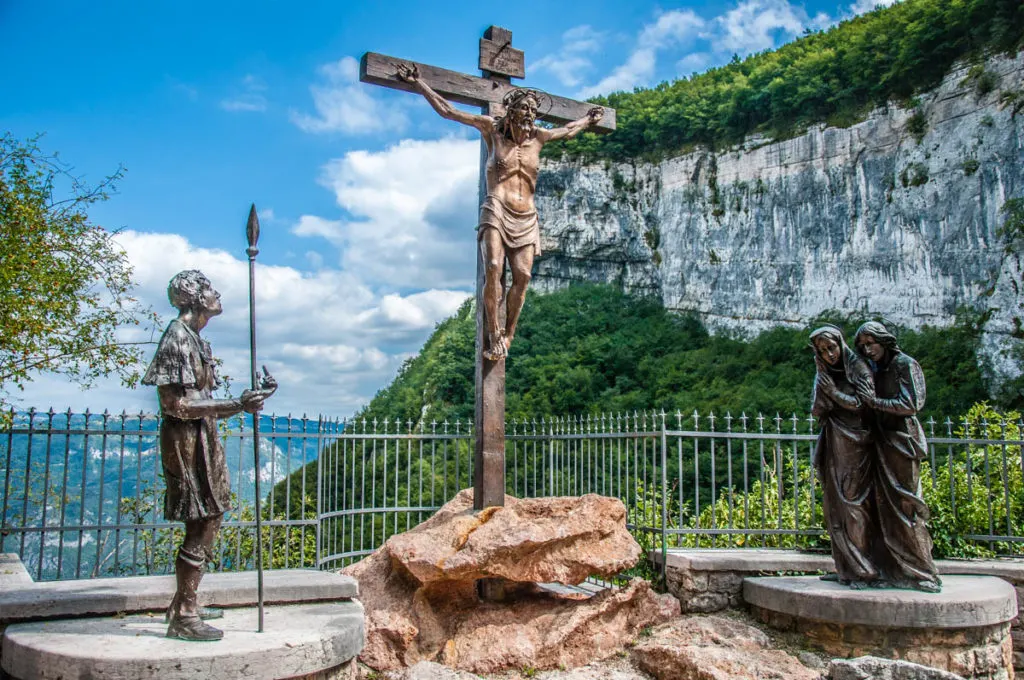
1. Via Crucis – also known as the Way of the Cross or the Way of the Sorrow in English, this is a path flanked by the fourteen Stations of the Cross. Each station represents an event in the Passion of Christ – from his condemnation by Pontius Pilate to his death on the cross and entombment. Walking from station to station is a type of Christian pilgrimage as people pray and contemplate the suffering of Christ.
The stations along the Via Crucis leading from the small village of Spiazzi to the Sanctuary of Madonna della Corona were sculpted by Raffaele Bonente – an architect and artist from nearby Verona. It took him 34 years to complete the full-size multi-figure groups.
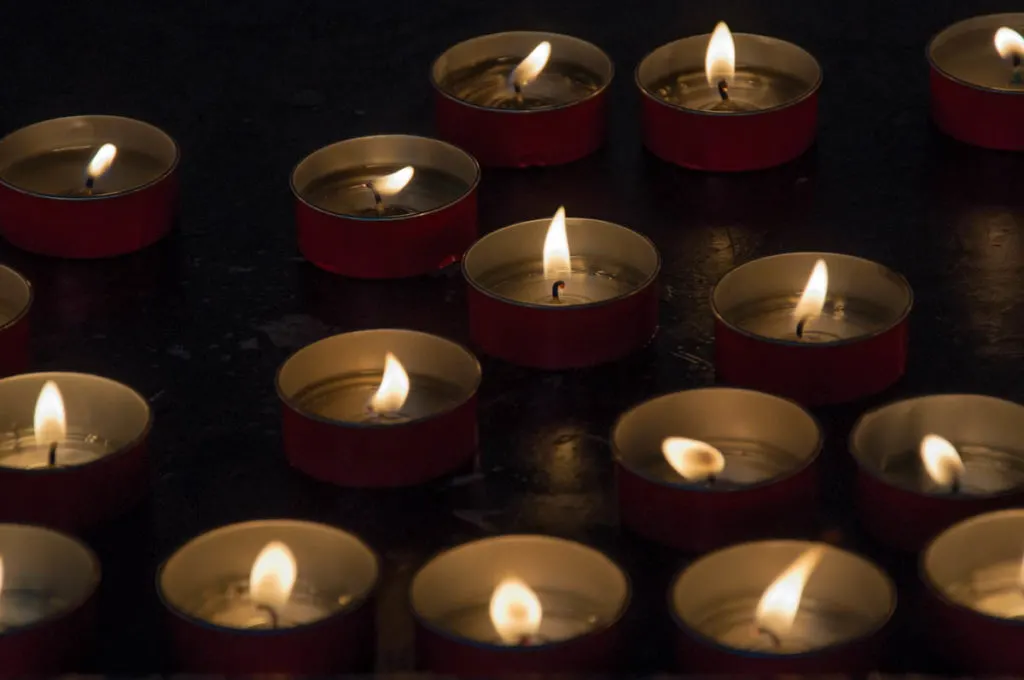
2. Stone gallery – a gallery cut in the rock in 1922. Whereas before people had to navigate a steep flight of steps, the gallery nowadays allows them to reach the sanctuary more easily and safely. Inside the gallery, you can light a candle and say a prayer.
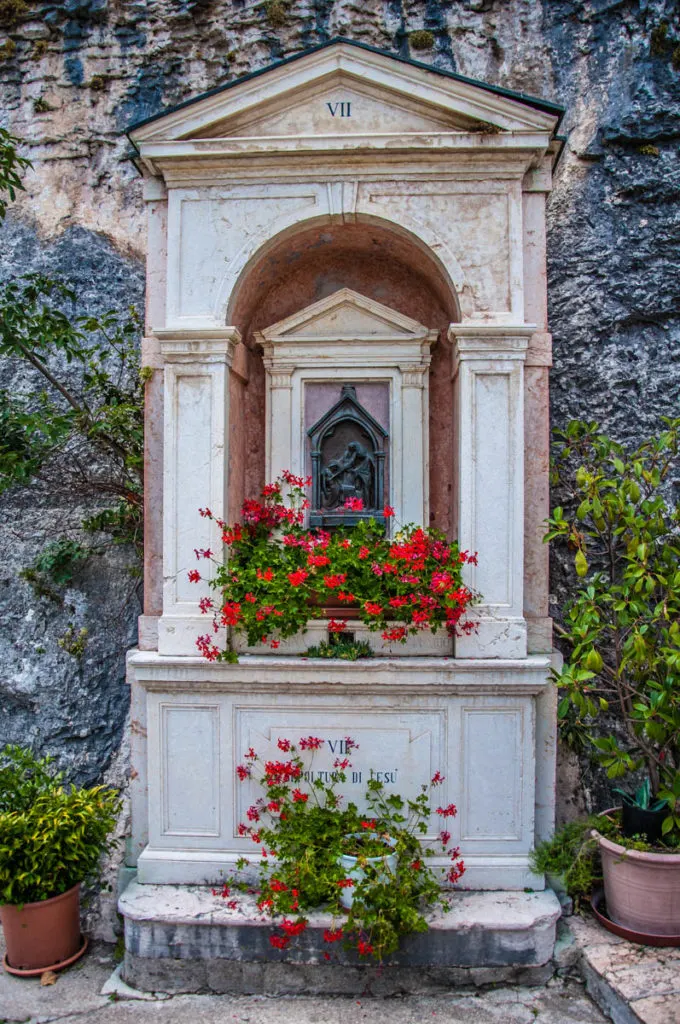
3. Via Matris – the short alley leading to the steps of the sanctuary’s church is flanked by seven small chapels – each with a bas-relief set in a marble arch in the classical style. They represent the Seven Sorrows of the Virgin Mary.
They are the work of the sculptor Ugo Zannoni from Verona. Many of the statues in white Carrara marble on the facade and in the interior of the church are also authored by him.
4. Pietà – this is the statue of the Virgin Mary cradling the body of Christ which has been at the Sanctuary of Madonna della Corona since the first half of the 16th century.
As explained above, there are two main stories about its arrival. One states that the statue was transferred by angels from the island of Rhodes. The other – that it was donated by a local feudal lord. You will see the Pietà in the centre of the apse inside the sanctuary’s church.
5. Madonna del Monte Baldo – a 14th-century fresco of the Madonna and the Child Jesus. Nowadays you can see it above the Chapel of Confessions. This was the first image venerated in the very first chapel built here in the Middle Ages.
6. Chapel of Confessions – it stands halfway up the stairs leading to the sanctuary’s church. Apart from the 14th-century fresco, here you can also see the replica of the Scala Sancta.
7. Scala Sancta – known as the Holy Stairs in English, this is a set of 28 steps made of marble. The original Scala Sancta was the staircase of the palace of Pontius Pilate. Jesus climbed it on his way to trial during his Passion. He was flagellated and his blood tinged the steps.
The Scala Sancta was brought from Jerusalem to Rome in the 4th century AD. Nowadays it is preserved in the Pontifical Sanctuary of the Holy Stairs near the Archbasilica of St. John Lateran in the capital of Italy.
The Scala Sancta has been recreated in several places in Italy and the world. The Sanctuary of Madonna della Corona houses one such replica. Traditionally, the Scala Sancta needs to be climbed by believers on their knees. They also need to stop at each step to say a prayer and reflect on the Passions of Christ.
8. Stained glass windows inside the church – they are beautiful and represent the mysteries of the Rosary.
9. Ex-voto – a collection of 167 votive offerings of different shapes and sizes. The oldest one is from 1547. It was donated to the sanctuary in thanks for the miraculous saving of a woman from drowning in the River Adige.
10. The exhibition Mater Dolorosa – a collection of 80 highly venerated statues of the Pietà.
11. The hermits’ burial ground – glass urns contain the remains of some of the hermits who used to live here many centuries ago.
12. Six Veronese bells – cast in 1884, their silvery voices are very moving. Hearing the bells ring while you take in the beauty of the sanctuary in the mountain’s bosom is a very special experience.
How to Reach the Sanctuary of Madonna della Corona?

There are two main ways to reach the Sanctuary of Madonna della Corona. Choosing one over the other will depend on how much time you have on your hands and how physically active you want to be getting there.
Here they are:
1. Hiking the Pilgrim’s Path to the Sanctuary of Madonna della Corona – this is the traditional (and until a few decades ago, the only) way to reach the sanctuary. It is also known as the Sentiero della Speranza (Hope’s Path).
It’s a scenic hiking trail which starts from the small town of Brentino Belluno in the Lagarina Valley in the Province of Verona and takes you up to the sanctuary. The path is about 2,425 m long. It includes 1,540 steps. It has an elevation of 600 m and, they say, it can be covered in about an hour and a half to two hours.
If you choose to visit the sanctuary this way, please, let me know in a comment below how long it took you to climb the steps. I still mean to do this particular hike in Veneto but so far each time that I have visited the Santuario della Madonna della Corona, I have taken the easier option. See point 2 below!
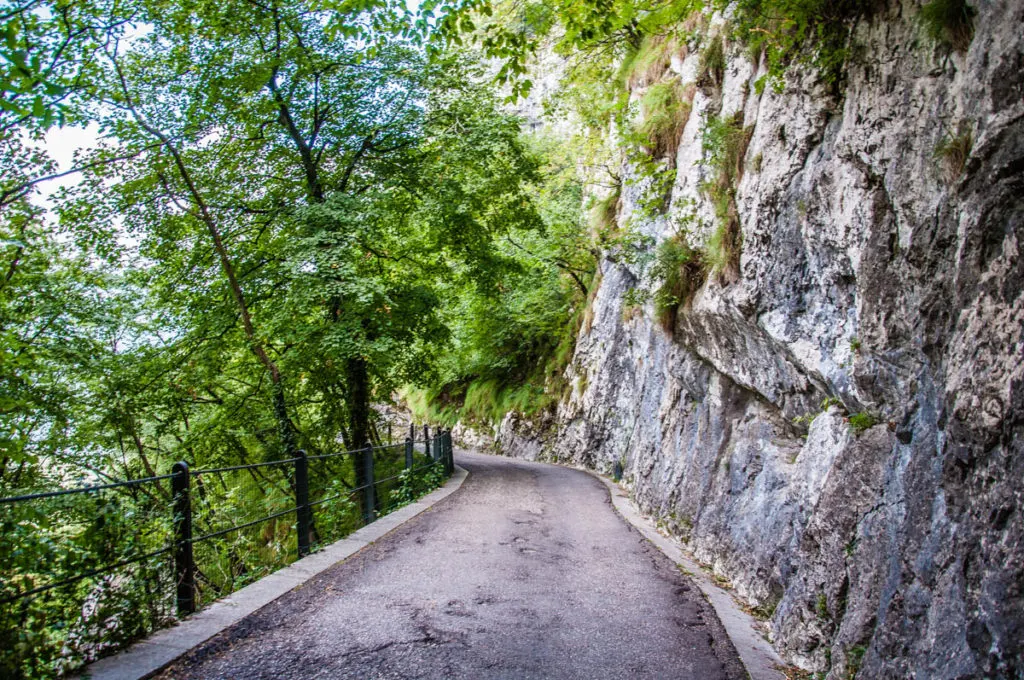
2. Reaching the Sanctuary of Madonna della Corona from Spiazzi – as noted above, Spiazzi is a small village at a height of 850 m above sea level. The road taking you to Spiazzi offers fabulous panoramic views over the nearby Lago di Garda – Italy’s largest lake.
The most convenient way to reach Spiazzi is by car. You will need to leave it at the large car park in the village. Arrive as early as possible during the high season and/or on religious feast days, as the sanctuary attracts an ever-increasing number of pilgrims and visitors. Usually, it’s not allowed to drive your car down to the sanctuary.
Otherwise, you can use public buses either from Verona or from one of the lakefront towns up to Spiazzi. Prepare for long travel times, fewer services during the low season, and having to change buses along the way.
For example, starting from Verona, you can take bus 173 to the small town of Caprino Veronese and once there change to bus 471 which goes up to Spiazzi. For up-to-date details about the network of public buses in and around Verona, check the website of ATV – the local bus company. In summer, you can also take bus 476 from the towns of Garda, Bardolino, and Cisano up to Spiazzi.
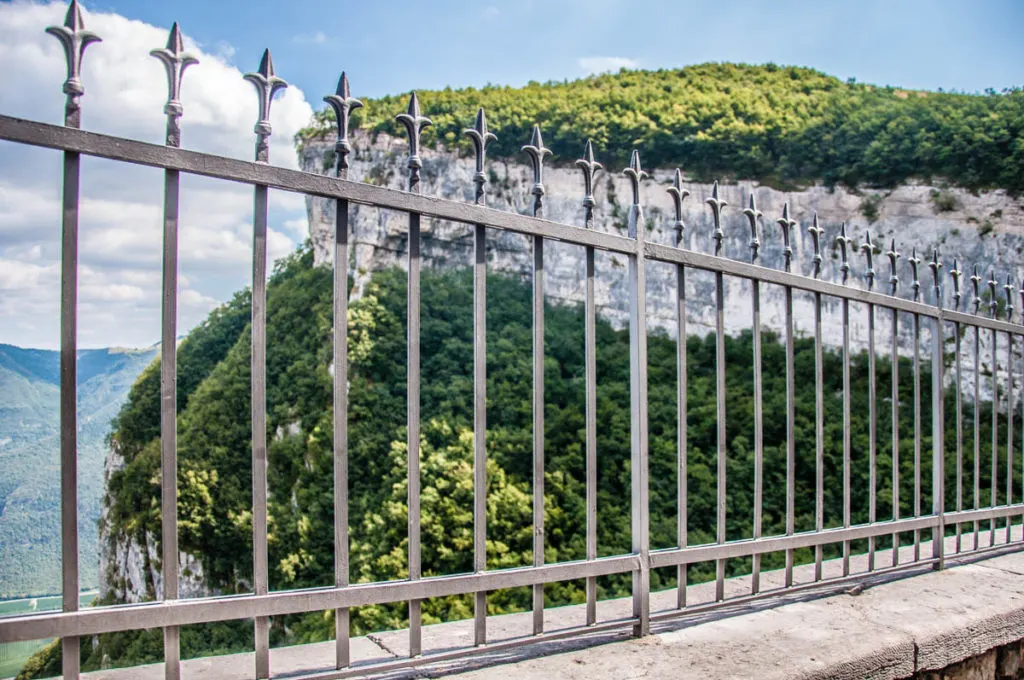
Once you reach the village – either by car or public transport – you have three options:
Shuttle bus – which will take you down to the sanctuary in about 10 mins. With few exceptions, the shuttle bus leaves from Spiazzi every half an hour on weekdays and every 15 mins on weekends and holidays. Click on the link for up-to-date information and ticket prices. The shuttle bus runs daily from April to September. Then it runs on Saturdays and holidays up to the 10th of December. The service is suspended the rest of the time.
Walk – you just need to follow the paved road which starts from Spiazzi and goes all the way down to the sanctuary. It’s under a kilometre and it’s the same road that the shuttle bus uses. It will take you past an alpaca farm followed by the Stations of the Cross by Raffaele Bonente. The road offers fabulous views over the vertical cliffs and the valley of the River Adige. A sturdy metal fence is in place as the heights are considerable.
Use the steps – there is a long flight of steps which leads from Spiazzi down to the sanctuary.
At the end of the road, you will find the gallery which was dug in the rock in 1922. People stop there to light candles before proceeding to the rocky terrace on which the sanctuary’s complex is built.
On my visits, I have always walked down to the Sanctuary of Madonna della Corona and on the way back I’ve climbed the steps up to the village. It is not a difficult trek but I always took my time as I would stop several times along the way first to say hello to the alpacas in the small farm nearby and browse the stall selling items made of alpaca wool, then to look at the Stations of the Cross, and then to take in the panoramic views of the valley and the sanctuary.
Practical Tips About Visiting the Sanctuary of Madonna della Corona
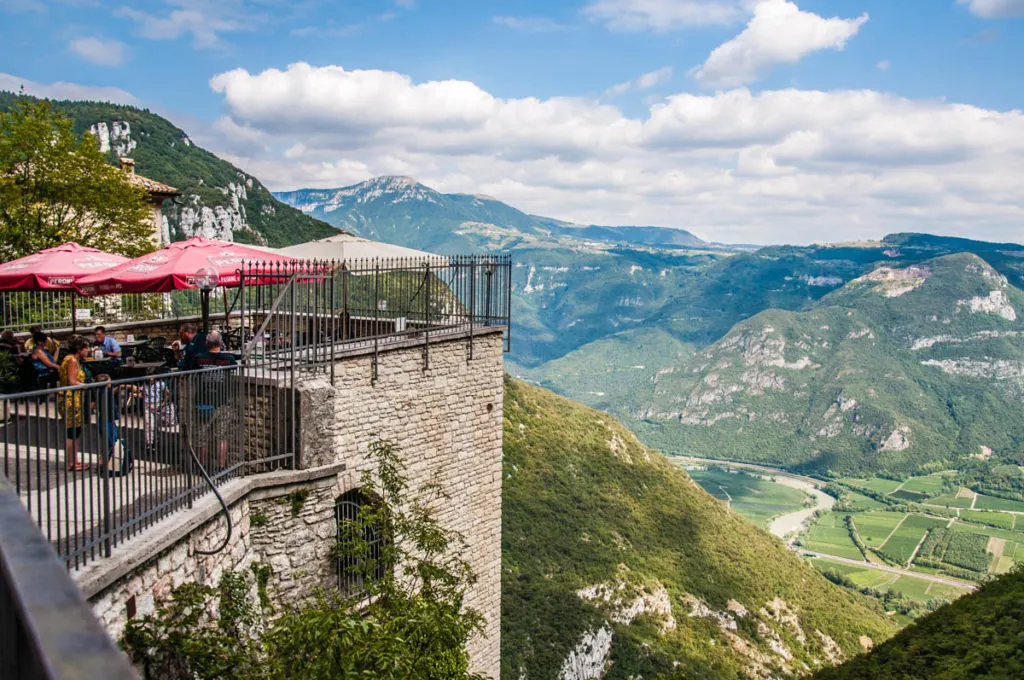
Here are my first-hand tried and tested practical tips to make your visit to the Sanctuary of Madonna della Corona in Italy as smooth and enjoyable as possible. Bear in mind that visiting the sanctuary is a pilgrimage in itself. No matter what your religious beliefs (or lack of) may be, visitors are expected to show respect for the place, its history, and its religious importance.
Dress appropriately – shoulders and knees should be covered in the sanctuary. If you don’t have a scarf, a jacket or anything else to cover yourself with, you can ask in the small souvenir shop on-site for a cape to use.
Wear comfortable shoes – if you decide to walk to the sanctuary, make sure that you wear comfortable shoes with good grip. The road from Spiazzi down to the Sanctuary of Madonna della Corona is paved but it has a steep incline. Also, the steps leading from Spiazzi to the sanctuary are rather steep and uneven, too.
Respect religious services – the Sanctuary of Madonna della Corona is a place of silence and reflection. Mass is held several times per day. Sightseeing and photo-taking during religious services are discouraged. You can still walk into the church during mass but it’s best to sit down and listen (if you don’t want to join in) instead of walking around and disturbing the proceedings.
Stay hydrated – in summer it can get rather hot up here. Bring a bottle of water with you. The sanctuary’s on-site cafe is a good place to have a drink and a light bite to eat. The cafe also has a spacious terrace with gorgeous views. There are several restaurants and cafes in Spiazzi, too serving local delicacies.
Check the official website for up-to-date information – always refer to the official website of the Sanctuary of Madonna della Corona for up-to-date information about visiting this extraordinary place. Click here to access the official website in English (it is also available in Italian, German, Spanish, and French). Click here to access the sanctuary’s Facebook page.
What Other Sanctuaries to Visit Near the Sanctuary of Madonna della Corona?
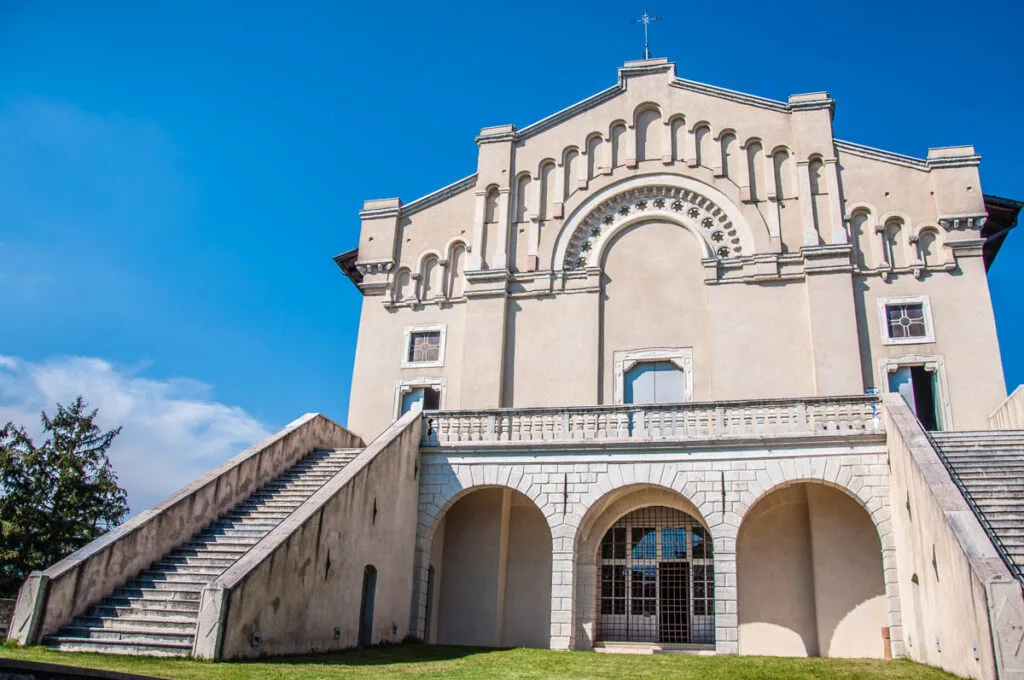
Three of Northern Italy’s most beautiful and interesting Christian sanctuaries are an easy trip away by car from the Sanctuary of Madonna della Corona. A visit to any one of them gives you a chance to explore the area on a deeper level.
If you are a quick sightseer and don’t mind driving around, you can try to see either one of these sanctuaries on the same day as Madonna della Corona or two of them on the day before or after. They are:
Sanctuary of Madonna del Frassino – this sanctuary stands on the spot of a miraculous event that took place on 11th May 1510. This is when the local farmer Bartolomeo Broglia was attacked by a large poisonous snake as he was walking across the countryside.
He prayed to the Virgin Mary to save him. At that moment a small statue of the Madonna appeared illuminated by a strong beam of light in the branches of a nearby ash tree (in Italian, frassino) and the snake slid away.
The small statue and the trunk of the tree can be seen to this day in the church built to commemorate the divine miracle. This sanctuary is near the lakefront town of Peschiera del Garda and you can reach it by car from Spiazzi in about 40 mins.
Abbazia di Maguzzano – this is a Benedictine abbey on the outskirts of the lakefront town of Desenzano del Garda. You can reach it by car in just over 50 mins from Spiazzi.
With a history that stretches back to the 9th century, the abbey has a beautiful Renaissance church, a small museum, and an iconography school.
Sanctuary of Montecastello – with its location on a steep mountaintop, this recently restored sanctuary provides breathtaking views of Lago di Garda. It stands on the western shore of the lake, so it will take you about two hours to get there from Spiazzi.
First, you will need to drive down to the lakefront town of Torri del Benaco. Once there, you will need to get the car ferry across the lake to the towns of Toscolano-Maderno. Then, it’s a scenic drive up the lake passing through gorgeous lakefront towns and past majestic villas and citrus groves.
The last stage of the itinerary is on the Strada della Forra – a road which follows an ancient canyon and opens splendid panoramas of the lake. It’s so beautiful that it was even featured in a car chase scene in the James Bond film Quantum of Solace.
Where to Stay Near the Sanctuary of Madonna della Corona?
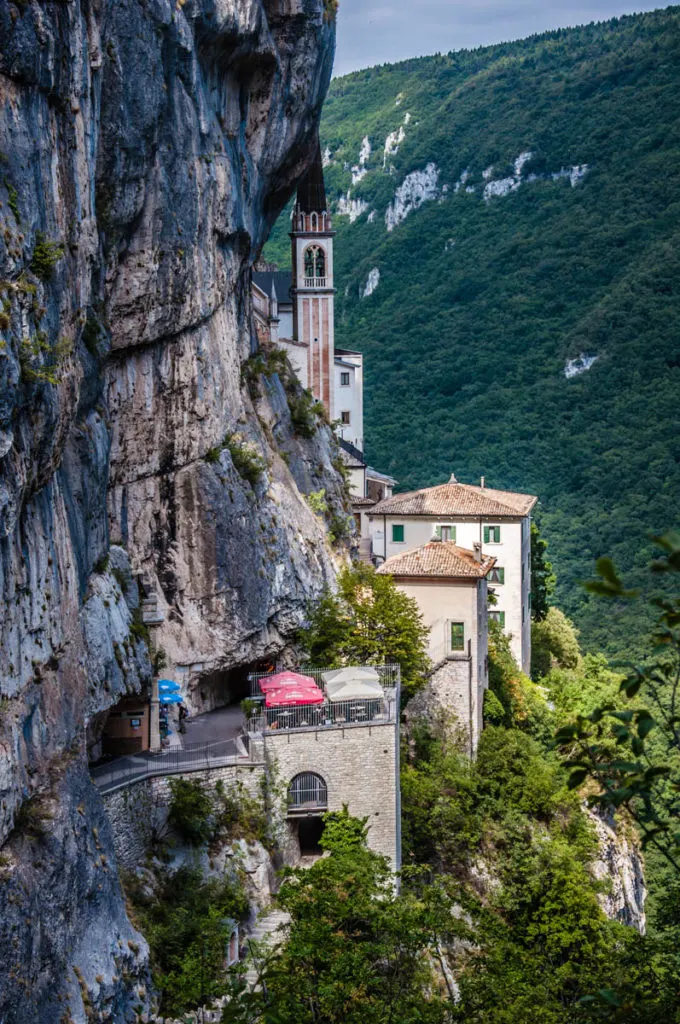
There is a variety of places to stay in and around Spiazzi, Lake Garda, and nearby Verona.
Here are some specific suggestions. All come highly recommended:
Spiazzi: Hotel Corona, Hotel Belvedere,
Southeastern Shore of Lake Garda: Sky Pool Hotel Sole Garda, Hotel Villa Anthea, B&B da Cesco
Verona: Hotel Accademia, Relais Balcone di Giulietta, Palazzo Monga Boutique Guesthouse
Alternatively, use the map below to get a quick visual idea of the available accommodation options in the area. You can zoom in and out, type in your specific travel dates, and then click on the different price points for detailed information about the hotel you want to know more about.
In addition, have a look at this blog post which explains the different types of accommodation you can book in Italy. It will give you plenty of ideas to look into for the best and quirkiest places to spend the night here:
Where to Stay in Italy – 19 Types of Accommodation to Suit Any Budget
What to Eat in the Area of the Sanctuary of Madonna della Corona?

For an exhaustive overview of the traditional foods, dishes, cheeses, desserts, and wines to taste in this corner of Lake Garda, have a look at this blog post:
The area is particularly famous for its chestnuts, olives, polenta, lake fish, and a large variety of locally made cheeses. Spiazzi is dotted with small restaurants and trattorias serving a great mix of mountain- and lake-inspired food.
If you are after a light lunch, the sanctuary’s cafe usually has a great selection of panini – different types of Italian bread stuffed with cheese and sliced meats.
What Else To Do and See Near the Sanctuary of Madonna della Corona?
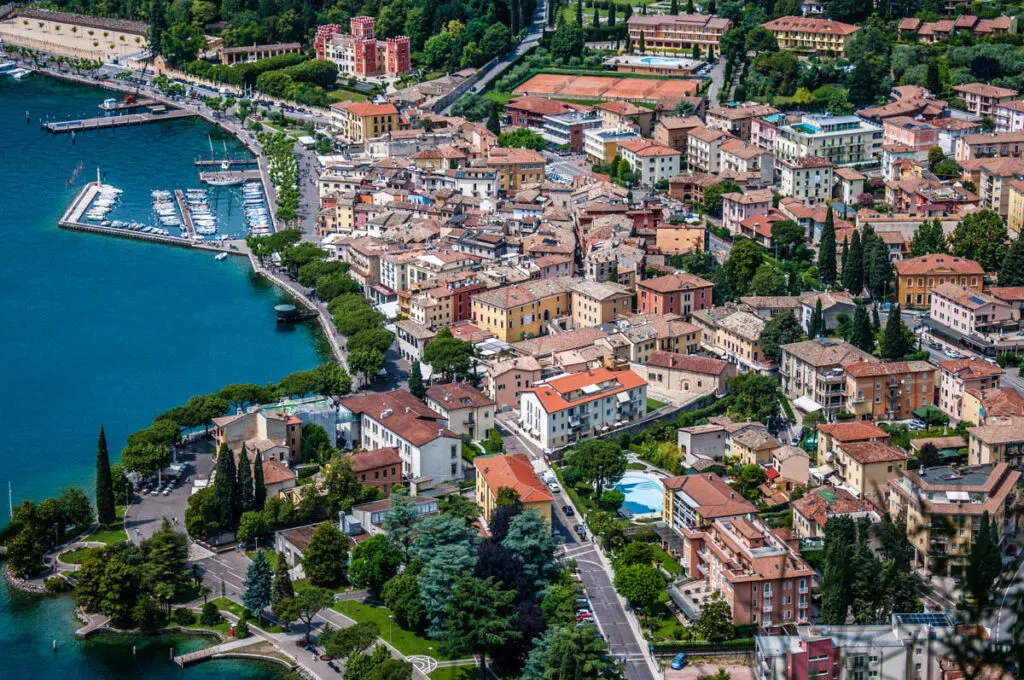
The Sanctuary of Madonna della Corona is a great full- or half-day trip from Verona, Vicenza, Padua, and most of the small towns around Lake Garda.
Nearby you can also visit:
Monte Baldo – a mountain range known as the Garden of Europe for its wide variety of plant life. From Monte Baldo, you can take the cable car down to Malcesine – a charming medieval walled town on the shores of Lake Garda. The cabin of the cable car swivels slowly as it goes up or down thus providing you with a 360-degree view of the mountain and the lake.
Garda Town, Bardolino, Torri del Benaco, Malcesine, Lazise, Desenzano del Garda or any other small town on the shores of Lake Garda. To help you choose, click here to see the best 20 towns to visit around Italy’s largest lake.
Valpolicella – a hilly area famous for the local vineyards and wine. It’s also dotted with beautiful little towns which are worth a visit.
Verona – the city of Romeo and Juliet is less than an hour away from the Sanctuary of Madonna della Corona. It’s lively, exciting, and has a rich plethora of sights – from Roman ruins and frescoed medieval houses to must-see museums.
Rovereto and Trento – two often overlooked northern Italian cities with plenty to offer in terms of history, beauty, and delicious food. Both are in the autonomous Italian province of Trentino and are easy to reach from Spiazzi in about an hour by car.
Have a look also at this blog post for even more ideas about things to do, hikes to enjoy, and sights to explore around Lake Garda:
Lake Garda Map – What to See at Italy’s Largest Lake
If you would rather have fun at one of Lake Garda’s amusement and water parks, this blog post has all the relevant details:
19 Best Theme Parks at Lake Garda, Italy – With Maps and Practical Tips
In Conclusion
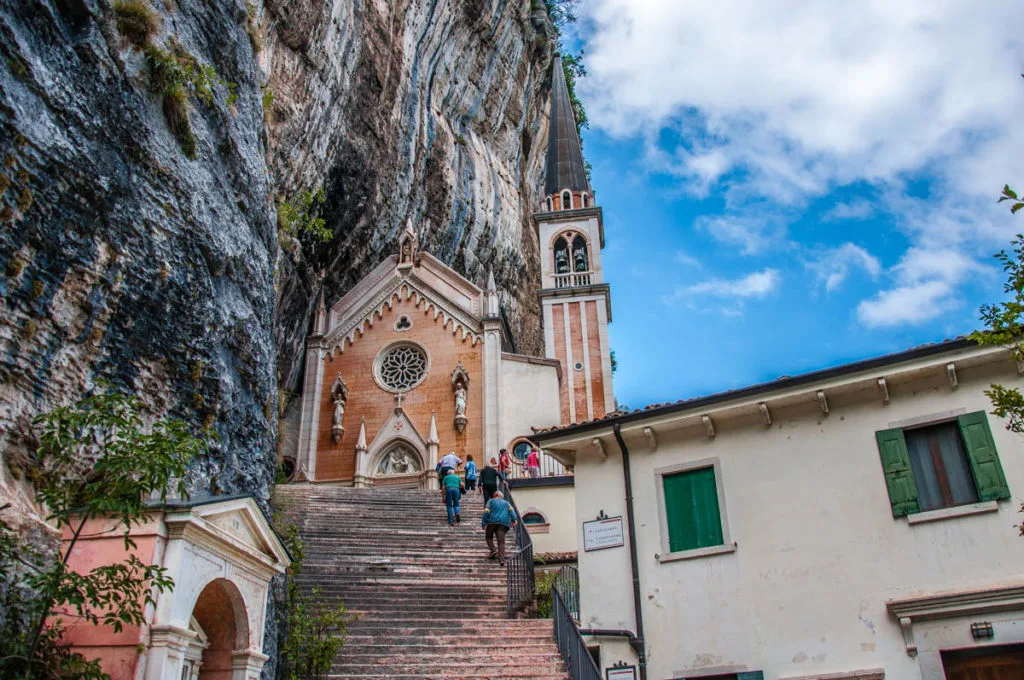
The Sanctuary of Madonna della Corona is a special place to visit in the north of Italy. Built on the vertical slope of a cliff in the Monte Baldo massif, the sanctuary appears to be suspended halfway between Heaven and Earth. It is easy to visit from the city of Verona and it’s also a short distance away from Lago di Garda – Italy’s largest lake.
A day spent at the Sanctuary of Madonna della Corona is a great experience in this corner of Italy. With a history that spans a millennium, this is a sacred place in the bosom of nature where you can enjoy splendid panoramic views and get close to the traditions and beliefs of a nation.
In this blog post today, I shared with you lots of first-hand tried and tested information about how to visit the Sanctuary of Madonna della Corona in Italy by yourself. From how to get there, what to see and do nearby to where to stay and what dishes to sample from the local cuisine, there are lots of details to help you during the planning stages of your Italian holiday.
Have a wonderful time in Italy!
Click on the links below for even more helpful information about the best things to do in this exciting country!
Travel Tools
Get Ready for Your Trip to the Sanctuary of Madonna della Corona in Italy
Get a guidebook from Amazon.
Buy plane tickets, train tickets, and bus tickets through Omio.
Research accommodation on Booking.com.
Select local tours and activities on GetYourGuide, Viator, and Tiqets.
More Helpful Italy Info for You
Best of Italy: Italian Piazzas, Italian Markets, Accommodation for Every Budget, Best Times to Visit Italy, Italy in Summer, Italy with Kids
Italian Food: Best Italian Food Gifts, Cheap Italian Food, Rules of Italian Breakfast, Italian Breakfast Foods
Italian Coffee: Italian Coffee Culture, Italian Coffee Drinks, History of Coffee in Italy
Christmas in Italy: Fun Facts, Things to Do, Italian Nativity Scenes, Panettone, Christmas Guide
Northern Italy: Best Cities to Visit, Major Airports, Reasons to Visit
Lake Como: Travel Guide, Reasons to Visit in Winter, Best Towns, Best Things to Do, Milan to Lake Como, Nearest Airports, Getting Around the Lake
Lake Garda Towns and Villages: Best Towns, Lazise, Desenzano del Garda, Riva del Garda, Malcesine, Torri del Benaco, Punta di San Vigilio, Campo di Brenzone, Borghetto and Valeggio sul Mincio
Visiting Lake Garda: Travel Guide, Map of Lake Garda, Getting Around Lake Garda, Lake Garda with Kids, 8 Best Airports, Venice to Lake Garda, Verona to Lake Garda, Milan to Lake Garda, Bologna to Lake Garda
Verona: Things to Do in One Day, Verona Opera Festival, Day Trips from Verona, Romeo and Juliet Itinerary, Verona to Venice, Verona to Milan
Padua: Things to Do in One Day, 101 Facts About Padua, 10 Reasons to Visit Padua, Day Trips from Padua, How to Reach Padua
Vicenza: Things to Do, Day Trips from Vicenza, Best Museums, The Beauty of Vicenza
Treviso: Travel Guide
Veneto: Top Places to Visit, Unique Adventures, Most Colourful Places, Mysterious Places, Most Beautiful Lakes, Reasons to Visit, Main Cities, Prettiest Small Towns, Most Beautiful Villages
Lombardy: Best Cities and Towns, Reasons to Visit, Brescia
Friuli Venezia Giulia: Venzone, Most Beautiful Villages
Emilia Romagna: Bologna, Ravenna, Comacchio, Most Beautiful Villages
Marche: Reasons to Visit, Gradara, Frasassi Caves, Temple of Valadier
Umbria: Reasons to Visit Perugia
Campania: Naples
Thank you for reading! Leave me a comment, pin the images or use the buttons right at the top and at the end of this blog post to share it on social media.
For more useful information like this, like my blog’s page on Facebook and Instagram and subscribe to my strictly no-spam newsletter.
Pin This Blog Post!
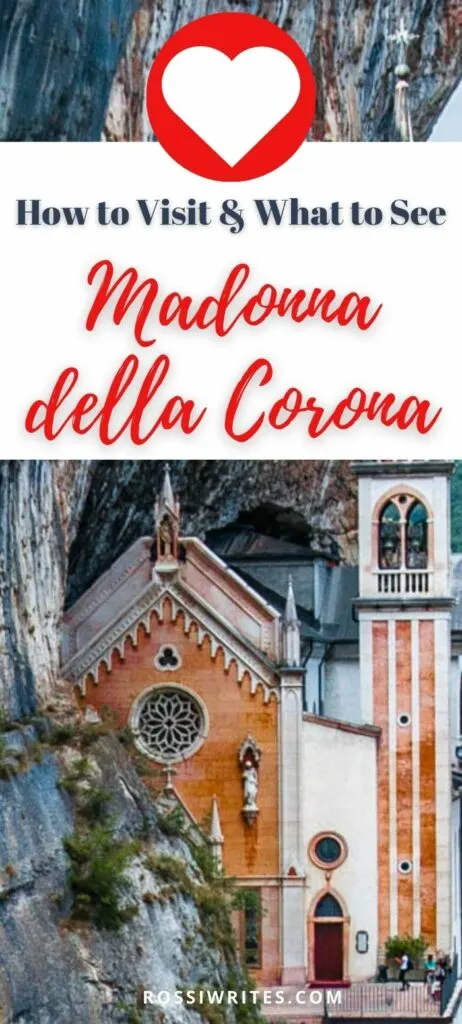
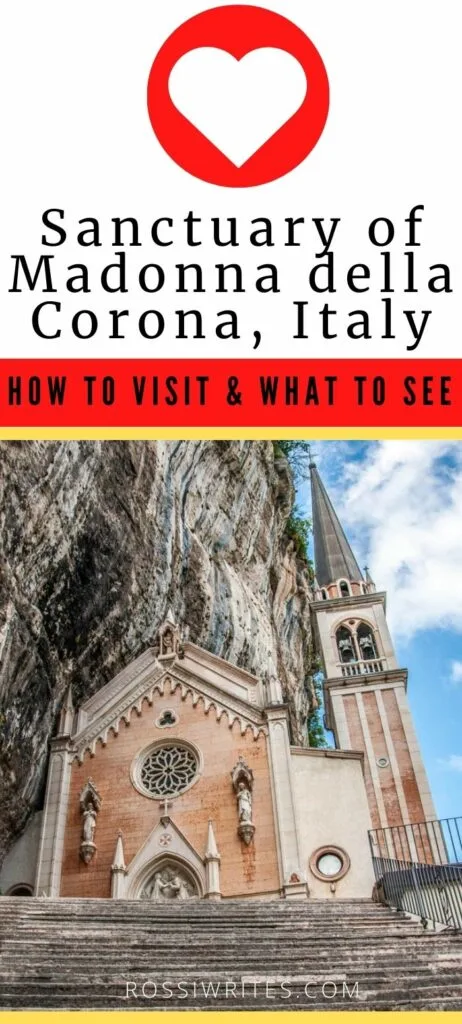

John
Wednesday 2nd of August 2023
I had never heard of this church until I found your website, but I have to say the Santuario Madonna Della Corona is 'right up there' (literally!) amongst the finest religious buildings I have ever visited. My only disappointment was that somehow I think I only found 7 stations of the cross.
We had hired a car for our holiday, so we parked in Spiazzi and walked to and from the church, along the Localita Gabbiola.
Thank you for the excellent information - the visit last month was a highlight of our fortnight in northern Italy.
admin
Wednesday 31st of January 2024
Thank you for your kind message, John! I am so glad you enjoyed your visit to the sanctuary. Please, accept my apologies for the delay in getting back to you. For some reason, I don't get notifications of new comments and if I don't check manually I miss some of them. Thank you again and
Best wishes,
Rossi
Sherri
Tuesday 17th of January 2023
Going there in May. Thank you for your excellent info. That will make things easier and answer a lot of my questions. Much appreciated!
admin
Tuesday 17th of January 2023
Thank you, Sherri! Have a wonderful time in Italy.
Best wishes,
Rossi :)
Peggy Morse
Friday 5th of August 2022
This looks absolutely incredible! Is there handicap accessibility? Are there handrails at the steps? Thank you for the information, I enjoyed your article immensely! God bless!
admin
Thursday 11th of August 2022
Dear Peggy,
Thank you for stopping by and for your kind comment. Please, accept my apologies for replying with delay. I was away for a couple of weeks and just picking up where I left with blogging. In reply to your question: as far as I recall, there are railings that run up the steps leading to the actual church. The railings are visible in the photos above. Otherwise, there is a shuttle bus which connects the village of Spiazzi to the sanctuary thus making it possible to reach it without walking downhill and then uphill on the way back. The bus stops by the small tunnel (described above). Then, there is a short path leading to the bottom of the steps for the church. You may want to contact the sanctuary for any more specific details. Their contact details are at: https://www.madonnadellacorona.it/en/contact-us/ The sanctuary has a residence where accommodation is provided for disabled pilgrims, so there may be also other provisions for handicap access there which I am not aware of. Thank you again and
Best wishes,
Rossi Thomson
Kathy McMahon
Friday 31st of December 2021
Thank you for such detailed information. The travel details you provide is always what I’m looking for. Much appreciated!! We will be in Verona this May and I’ve been wanting to visit this beautiful church. If we choose not to rent a car, would we just catch the train to Garda and then a bus to Spiazzi? Do you know what bus line that would be? Thanks- Kathy
Jauaperi
Friday 23rd of December 2022
@Kathy McMahon, estamos com essa mesma dúvida de ser viavel sair de Verona de transporte publico. Voce conseguiu? Poderia detalhar? Agradeço muito.
admin
Saturday 1st of January 2022
Dear Kathy,
Thank you for stopping by and for your kind words. In reply to your question: two towns on Lake Garda have train stations. These are Desenzano del Garda and Peschiera del Garda. Otherwise, there are buses that connect Verona to several of the lakefront towns. The bus lines from Verona to Garda Town are 162, 163, 164, and 165. There is a bus which connects Garda Town to Spiazzi. Unfortunately, it is only operational in Summer (between June and September according to the official website). Have a look at these links in English by the transport provider for current information: Bus Lines from Verona to Lake Garda: https://www.atv.verona.it/en/LineeLago (currently shows the winter timetable) Seasonal Bus Line from Garda Town to Spiazzi: https://www.atv.verona.it/flex/cm/pages/ServeBLOB.php/L/EN/IDPagina/136 (scroll to the bottom of the page to see the relevant details for bus line 476) To be honest, I have never used public transport to go to the sanctuary and as such don't have first-hand information on this. If you are visiting outside of the seasonal bus timetable, keep an eye on https://www.rome2rio.com/map/Garda/Spiazzi-Veneto-Italy - it shows you different options to reach the village from Garda Town and an estimate of the cost. At present (and it's the low season), these are only by driving there or getting a taxi. Or you can use the same website to check different itineraries to Spiazzi from different points of departure. I hope you find a way to visit and have a wonderful time there. It's a beautiful area.
Best wishes,
Rossi :)
Emilio Camilli
Wednesday 17th of November 2021
Caio Rossi, fantastic and informative article about this beautiful, awe inspiring sanctuary. Im visitng Italy in June and July in 2022,,and will make this a must- see visit, based on your article. I'm not sure what day you visited,but just wanted to guage if its less crowded during the week,than on weekends? Thank you for the informative post, and happy traveling! Caio e auguri. Emilio
admin
Thursday 18th of November 2021
Dear Emilio,
Thank you for stopping by and for your kind words. The sanctuary is very beautiful and a very special place. It attracts a large number of visitors, especially around religious celebrations and during the high season from May until September. It really depends but in principle weekdays tend to be a bit quieter. You never know though. I hope you have a wonderful time visiting the sanctuary and the surrounding area!
Best wishes,
Rossi Thomson :)